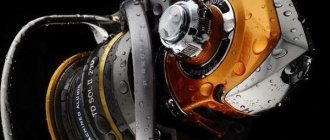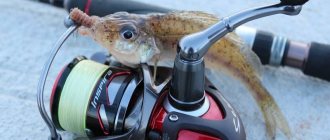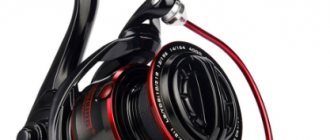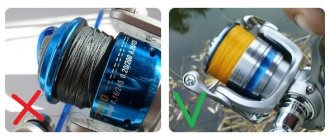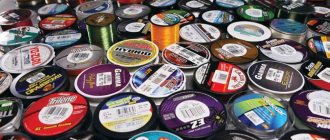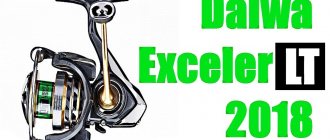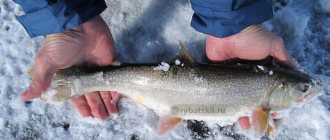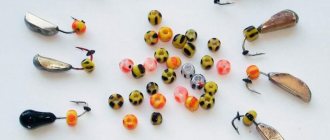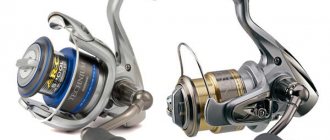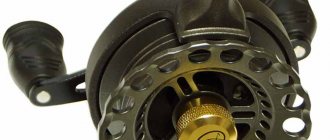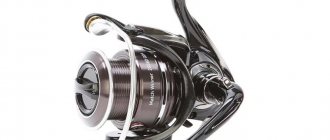The reel is the part of the fishing rod on which the fishing line is wound and attached. With its help, a cast is made and its distance is adjusted depending on the type of reservoir and the type of fish caught.
Today, the range of reels is impressive, but not all are suitable for fishing with a float rod.
This tackle for a float rod is divided into two types:
Inertia coil
The inertial reel is lightweight, allowing you to hold it in your hand for a long time
Features: it is intended for close casting from the shore, in still water or in weak currents, as well as for fishing from a boat with a short rod.
Advantages:
- lightweight, allowing you to hold it in your hand for a long time;
- This type of gear has a ratchet, which is very convenient when biting;
- quickly hooks and catches fish near the shore;
- does not require a large amount of fishing line;
- quickly repaired.
Flaws:
- does not have a clutch for releasing the fishing line when fishing for large fish;
- it is almost impossible to make a long cast more than 10 m;
- does not have a clip for precise casting to the same place;
- when trying to cast as far as possible, the line often becomes tangled;
- Difficulties arise when landing large fish.
What is a wire reel
A wire coil is also called an inertial coil. This definition establishes the structure of the equipment. The spool is mounted parallel to the movement in the forests during reeling or casting. Thus, the cast equipment overcomes the torsional inertia of the spool.
There are two types of coils. Simple with a small diameter that does not exceed 60 mm. This model is made of plastic or metal. It is preferable to use such equipment for winter fishing.
The second type has a larger diameter of 100 - 160 mm. It should be used for vertical trolling, as well as fishing with bottom gear, and it doesn’t matter from a boat or on the shore.
In the past, such models were used by spinners, but now such equipment has been replaced by inertia-free models.
Spinning reel
The spinning reel has a removable handle for easy side switching for left-handed or right-handed people
Features: designed for both long and short casting.
Advantages:
- has a clip for precise placement in the right place;
- there is a friction clutch in order to catch large specimens, while reducing the loss of fish and damage to gear;
- a large amount of fishing line is placed in it;
- has a removable handle for easy side switching for left-handed or right-handed people;
- In case of equipment breakdown, any part can be replaced.
Flaws:
- in close casting it gives slack when hooking;
- If you wind it too much, the fishing thread will become tangled.
Any fishing equipment element has its own positive and negative nuances. But not unimportant is the correct selection of equipment for a particular type of reservoir, the type of desired trophy and the skills of the fisherman himself.
How to cast a spinning rod with an inertial reel
It only takes a few hours for a novice spinning angler to learn how to cast and then lead a lure. It is enough to follow certain rules:
- Side cast:
- When casting from the right, the reel should be positioned above the rod, on the left - vice versa;
- The spoon should hang 20-30 centimeters from the end of the rod;
- Press the line to the rod with your finger and turn off the reel stopper.
- Taking the spinning rod back, we make a smooth, strong movement forward. At the same time, we try to ensure that the tip of the rod moves slightly upward. Don't forget to let go of the line.
- Overhead throw:
- In this option, do not place the spinning rod far behind your back;
- Don't use too much force when casting;
- The spinner should describe an elongated arc in the air.
How to choose a reliable reel
Knowing in theory about the types of coils and their main characteristics is, of course, wonderful. But you also need to be able to not be deceived when buying and choose really high-quality gear at the right price.
Therefore, when choosing an inertial type of gear, you need to remember:
- The mounting base must be metal , the thickness of which must be at least 0.2 mm;
- All parts must be firmly fixed so that none of the elements dangles in the air;
- The spool is attached to the base of the tackle with a bolt and nut. Other types of fasteners break quickly;
- The ratchet should work with moderate line tension. A weak ratchet will interfere with casting and retrieving fish;
- There should be no cracks on the base of the fastening ; if there are any, then this gear is used;
- The presence of a latch or a trigger for removing the ratchet is a mandatory element. Without it, the line will often get tangled and make noise when pulling the fish.
The main points in inertialess gear:
- play in the spool and any loose parts when turning the handle;
- There should be no notches or holes on the spool so that the fishing line can be removed smoothly and the float will smoothly fly into the distance;
- You definitely need to check if the clip works. The line should not be pulled from the reel after the click;
- The clutch should lower the line smoothly without jerking or snagging ; the more the angler loosens, the easier the thread should come from the spool.
And in order to avoid unpleasant moments when purchasing, it is better to purchase such goods in a specialized store rather than in the market. In addition, the store provides warranty service for its product and the possibility of free replacement or repair during the entire warranty period.
Collecting fishing gear
Fishing equipment for catching fish in a retrieve must combine not only the design and installation of equipment (rod, line, hooks, sinker, float, reel) but also knowledge of other aspects (bait, feeding). Let's take a closer look at them, since the correct design for wiring is the main tool.
Rod selection
To fish with this method, you need a rigid and at the same time light stick, for example, a telescope 4-5 meters long, equipped with rings. They make it easier to unwind the fishing line, turning the fishing process into a comfortable experience. Feeder rods have also proven themselves to be good on retrieves, and the leger type is the best. Quite tough and light, they can withstand playing large fish and do not tire your hand. The optimal length of such rods is 360-390 cm.
Line selection
For fishing in the wire, the tackle is equipped with a main vein 0.22-0.3 mm thick (100-150 meters), to which a leash with a fishing line diameter of 0.14-0.2 mm and a length of up to 40 cm is attached using a swivel. The equipment allows the tackle be more catchy, and in case of a snag, only the leash is lost.
Coil selection
For this fishing method, you can choose any modification depending on how comfortable it is for the fisherman to use. When you first try to learn how to catch trophy specimens using the reeling method, you can get by with inertia-free models, which are in the arsenal of all fishermen. Reels of this type are good for long, precise casting and when fishing in inconvenient places.
The advantages of coils are:
- simplicity and accuracy of casting over long distances;
- ability to quickly reel out fishing line;
- the presence of a friction brake, which reduces the number of gear breaks.
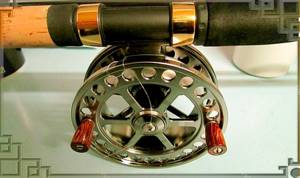
The main disadvantage is the lack of easy descent of the fishing line. Over time, you can switch to inertial types, which, when winding, prevent the veins from twisting, and when wiring, gently lower them, guaranteeing constant tension. The advantages of such reels:
- uniformity of line descent;
- absence of circles between the float and the rod on the water surface;
- ease of vein control;
- accuracy of casting into hard-to-reach places and when fishermen are crowded;
- minimal formation of “beards” when delivering bait.
To learn more:
Shitik in the house: caddis larvae as catchable bait
Float selection
Since wire fishing is carried out in the current, the buoys must ensure the smoothest possible movement of the equipment in the fishing areas and clearly indicate the moment of the bite. Such requirements are satisfied by models attached to the fishing line at the top and bottom. Floats with a long keel (guaranteed stability in currents and strong winds) and antennas in bright colors (they are visible when casting over long distances) are suitable for use.
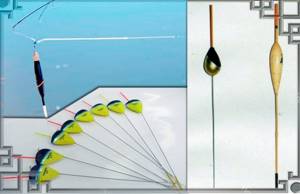
These floats are appropriate in cases where fishing by wire is carried out at depths comparable to the length of the fishing rod. In other conditions, it is appropriate to use sliding structures.
Sinker selection
The optimal installation for weighting fishing tackle is to mount several lead peas below the float. The heaviest one is placed under the bite indicator, then a smaller droplet, and the lightest one at a distance of 10-15 cm from the hook. This is the best design for cases when fishing in the current takes place.
You can also load the tackle with one sliding-type lead droplet. Such equipment is appropriate when casting over long distances. The disadvantage is low sensitivity and lack of good “play” of the nozzle.
Requirements for hooks
The Bolognese fishing rod for retrieving requires careful selection of the tip for the nozzle. Preference depends not only on the size of possible trophies, but also on the size of the bait. For example, for maggots, a point with an extended fore-end No. 12-14 would be acceptable. Accordingly, for a leech or a worm you will need a larger size. Regardless of the size and shape, the hooks must be strong and sharp in order to reliably hook the fish and not lose it during the fishing process.
Selecting a nozzle type
Maggot has proven itself to be a stable bait that works in different weather conditions for wire fishing. Based on the size of the hooks, 3-5 larvae are placed on them, piercing the edge of the head with the tip. It is advisable to hide a sting in one of the maggots.
The bloodworm proved to be no less catchy bait. But before fishing in the retrieve on the river (Oka, Buzan, Volga, Don) or other waters, you must remember that this bait is quite delicate and cannot withstand more than one cast. Bloodworms are also a very consumable bait, but as part of a “sandwich”, supplemented with maggot larvae, it promotes good results.
Directly near the fishing spot you can find burdock caterpillars, bark beetle larvae and caddis flies. Such baits work well in the spring and not only attract fish, but also give them a wild appetite. Knowing the habitats of larvae and caterpillars, you can save tens of rubles.
To learn more:
The best weather for pike fishing
Vegetable baits are also used for wire fishing. Some fish species, such as ide and roach, prefer them. At home, you can prepare pearl barley and rolled oats, boil peas and semolina porridge. Sometimes even balls of white bread crumb become a delicacy for fish.
Choice of bait
When planning to fish with a wire, it is not necessary to stock up on a large number of baits that attract fish. But it is also impossible to say that they will be superfluous. With the help of soaked bread crumbs, pearl barley grains mixed with clay and sand, you can attract a large flock. The main thing in this matter is not to overdo it and not to overfeed the object of the hunt. Otherwise, the satiated river inhabitants will stop responding to any bait.
Popular reel models
When choosing a model of this tackle, it is important to remember that the spool on it should not be large or deep.
In inertia models, the differences between brands are not so significant, but when choosing inertia-free models, the difference is huge. You need to choose them by understanding exactly how long you will need to cast and how much weight of fish you will have to pull.
That is why it is better to give preference to the following models:
Shimano Super Gt 4000S Rc (Rear Drag) . High-quality tackle from a Japanese company. It is in great demand among experienced fishermen and athletes. Made of aluminum and graphite, the gear ratio is 4.8 rpm. Average price from 9500 rub.
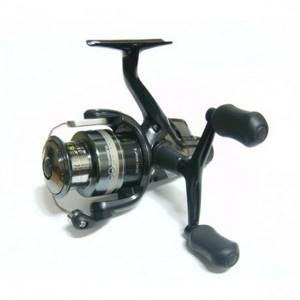
Daiwa “DF Cat 100” is an inertia-free type of gear, the body of which is made of aluminum. This makes it possible to apply maximum loads to it. The spool has a large capacity. The friction clutch can withstand weight up to 15 kg. The tackle weighs on average 850 g. The cost of such tackle when ordering online is approximately 4,000 rubles; purchasing in a retail store will cost 4,500-4,800 rubles.

Mikado ACE MATCH 4006 FD is a spinning reel with 6 bearings. Friction – front. The diameter of the spool and rotor has been increased. Tackle weight – 305 g. Perfect for float fishing at depth or spinning winter fishing. The price ranges from 2700 to 3200 rubles.
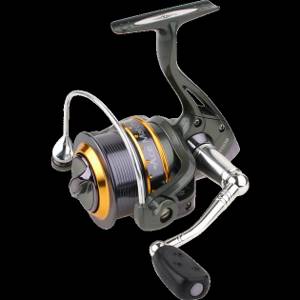
Aqua “Calypso 1000”, 9+1 – a spinning type of tackle with 9 bearings and a front clutch. The work is based on an endless propeller, which helps increase the casting distance by more than 30%. The fishing line is wound crosswise without getting tangled, maintaining the reserve and quality of winding for a long time. Aluminum body, carbon fiber washers. A big advantage is the presence of an anti-twist system in the line roller. This mechanism is able to withstand the most extreme loads. Average price from 3750 rub.
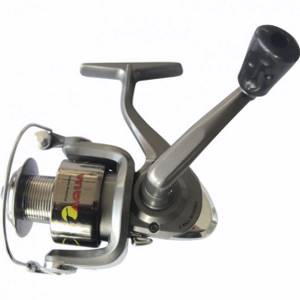
When choosing a model, special attention should be paid to the case material. If it is made of cheap plastic, such tackle will not last long. An aluminum case would be a good option - it is lightweight and at the same time reliable, and copes well with various loads.
Advantages and disadvantages
Inertia coils have a number of advantages over inertialess ones:
- The first advantage is the relatively simple design of the inertial coils. A drum with several handles, equipped with a brake, is placed on a shaft fixed in the housing. Additionally, you can install a pair of bearings. Nothing more is required.
- The second advantage is the significant capacity of the drum. This makes it possible to use a large amount of fishing line of any diameter, which means it is possible to catch large fish.
- The third advantage is the high sensitivity of a spinning rod equipped with an inertial reel. This allows the spinner to feel the movement of the bait on the line, catch the moment of swallowing the bait (this will allow him to react instantly and carry out the most effective hooking), and track the movement of the fish and its jerks.
- The fourth advantage is the price, lower than that of other types of reels.
- The fifth advantage is the experience of fishing with an inertial reel. Experienced fishermen started fishing using a spinning rod with this type of reel and remained faithful to it.
However, there are a number of disadvantages of inertial coils over inertialess ones:
- Quite low line rewind speed. You can make a calculation using the example of the popular Nelma-type coil. Its diameter is 114 mm, and its circumference is 35 cm. For each revolution of the drum, one turn of fishing line is wound. This means that for every meter of fishing line you need to make less than three turns of the reel, which is by no means a good result. Enlarging the drum will make the reel heavier, which will not be a solution to the situation.
- Low casting range of baits. Such a cast when using an inertial reel requires significant physical effort. When using a spinning reel, such casting is easy.
- The inevitability of beards. In strong winds or if the bait hits an obstacle, the fishing line tends to get tangled around the reel. This happens especially often among novice fishermen. When using a spinning reel, this problem disappears by itself.
Rigging a fishing rod with a reel
Attaching the reel to the fishing rod takes place in several steps:
- First you need to unscrew the nut a short distance and move the stop a little;
- Insert the coil into the resulting opening and firmly tighten the nut to its original position;
- Next you need to wind the fishing line. It should be noted that the fishing line is already wound onto the fixed tackle. The free end of the fishing line is threaded through all the rings of the fishing rod in turn, then passes to the end of the reel spool;
- Now you need to form a loop and put it on the spool. In order to provide sufficient resistance, you can thread a pencil or pen through the spool of fishing line;
- Open the cover of the line layer and you can start winding the line with slow movements. After finishing winding the fishing line, the lid must be closed.
- The next step is to secure other elements of the equipment (float, weight, leash, hook).
A properly secured reel will ensure the integrity of the equipment and uninterrupted catching of fish trophies.
Blitz tips
When going fishing, you need to remember a few important tips:
- The lighter in weight all the elements of the equipment are, the better the bite will be noticeable. However, do not forget that in this case, casting over long distances becomes impossible;
- For a float fishing rod, floats weighing 0.5-12 g are best suited. The decisive factor when choosing is the type of fish and the type of reservoir;
- Small pellets or olives are suitable as weights
- You can use a variety of hooks from 2.5 to 10 numbers;
- When purchasing a reel, you need to pay attention to its test exposure;
- It is better if the spool is metal - this will increase the casting distance and accuracy.
A high-quality reel and its correct fastening will ensure a more sensitive hook and accurate casting of the fishing rod.
And in the skillful hands of a fisherman, they will increase the likelihood of a catch and minimize possible damage to the equipment.
Modifications
There are a variety of modifications on the market, differing in price, fishing method and type of design. Beginning fishermen choose simple, inexpensive options that have a small drum on a cylindrical axis. Budget models are suitable for line fishing, but when casting gear, novice fishermen often fly off the line from the spool groove and form a tangled “beard”. Sometimes there are difficulties with casting heavy bait or spoons over long distances.
Inertial models have a decent rewinding speed. Rare breakdowns are due to the simplicity of the design, and reels made of high-quality materials with ball bearings can reliably serve for any fishing method.
Coil parts are made from various materials:
- carbon fiber reinforced plastic and various polymers;
- stainless metal and steel;
- aluminum and brass alloys;
- ceramics.
Modern reel models are made in the form of a figured cone mounted on an axis. More complex modifications cost a decent amount due to the accuracy and quality of components and parts. They are distinguished by convenient winding and silent operation of the spool when casting.
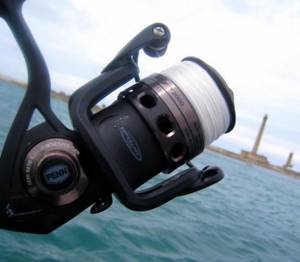
Recently popular reels were: “Nevskaya”, “Donskaya” and “Nelma”. Their modifications are used by novice fishermen.
- "Nevskaya" has a reliable design. A steel axis is fixed in the body, on which a drum with a pin with a diameter of 130 mm is located. There is a ratchet on the back cover. 80 meters of fishing line with a cross section of 0.5 - 1.0 mm are freely wound onto the drum. Weight – 0.23 kg.
- “Nelma” is similar to models of modern inertial reels from different manufacturers. A modification has been made to the braking system - aerodynamic shoe brake. Weight with fishing line is more than 200 grams. The 114 mm drum holds up to 100 meters of fishing line (0.5 mm). The presence of bearings in the design ensures smooth running.
- “Donskaya-2” is a reliable reel with a large (160 mm) drum and a metal body, weighing 0.4 kg. Suitable for any type of fishing rod. Despite the absence of bearings, the rotation sleeve allows for smooth winding of the fishing line onto the bobbin. The brake system is a classic ratchet.
Used models are in demand on the secondary market.
Drum
Wiring reels are available with different types of bobbins. There are models with small and large bobbins, which differ in weight, size, groove for the fishing line and winding volume. The drum is mounted on an axle with a cover, on the back of which there is a brake mechanism. The diameter of the drum affects the speed of winding the line. The casting distance of the bait depends on the size and type of model.
Expert opinion
Knipovich Nikolai Mikhailovich
Zoologist, hydrobiologist. I am interested in fishing at a professional level.
Advice. For good casting and smooth landing of the tackle on the water surface, reduce the speed of the spinner's flight with the braking system (1-2 meters before landing on the water).
Inertia-free reel models are sometimes used for line fishing. The design is made with a cone mounted on an axis. The models are distinguished by high winding speed and easy casting. The winding force depends on the length and location of the handle lever. Models are produced in different price categories. Expensive “premium” class options are chosen by professionals with many years of experience and collectors.
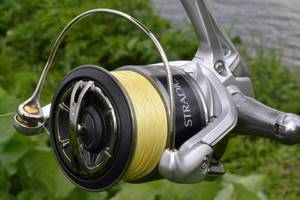
A simple budget design of a wiring coil consists of several elements:
- bobbin;
- central landing axis;
- cover with fastening;
- brake system.
The material for the production of the drum needs to be light (due to the effect on the speed and casting distance), so models made of aluminum or its alloys - duralumin - are often found. In new models, the sliding bushing is replaced with cone systems. The production of reel designs with plain bearings remains relevant.
Brake system
Manufacturers make reels with several types of braking systems . Professionals rarely use a ratchet, preferring to control the bobbin rotation speed manually. The ratchet is used to tension the fishing line when transporting the fishing rod.
Expert opinion
Knipovich Nikolai Mikhailovich
Zoologist, hydrobiologist. I am interested in fishing at a professional level.
Advice. Changing the position of the tip of the spinning rod relative to your position will help you set the movement of the spinner in the water, simulating a swimming live fish. Carry out the wiring from left to right.
The weight of the tackle, the range and accuracy of its casting, weather conditions and the type of reservoir are factors that must be taken into account when choosing a reel with clamps.
Types of brake systems:
- aerodynamic;
- friction;
- locking;
- block
The aerodynamic design consists of an impeller whose blades create air resistance. The force is adjusted using a gate. The locking mechanism is switched by a ratchet. The reverse stroke is controlled by a lever on the drum. The design of the reel with brake pads is an improved version of the friction brake.
Line used
The choice of fishing line is influenced by a number of factors. Take into account the type of reservoir for fishing and the possible casting distance of the gear. If the river is 20 meters wide, there is no need to reel in the entire reel with fishing line. When catching large predatory fish, a reliable fishing line is chosen, with a diameter of about 1 mm. For catching small fish, choose line sections of 0.1-0.3 mm.
Professional fishermen take into account the condition of the reservoir. For muddy water, gray fishing line is suitable. On running water or in a clear lake, use green fishing line. This shade imitates the background of a pond. It is believed that an invisible fishing line in the water does not alarm the fish.
Rod mount

The reels are inserted into grooves located along the axis of the rod base. They are fixed to the threaded connection with clamps. There are homemade fishing rods with reels attached to car clamps.
